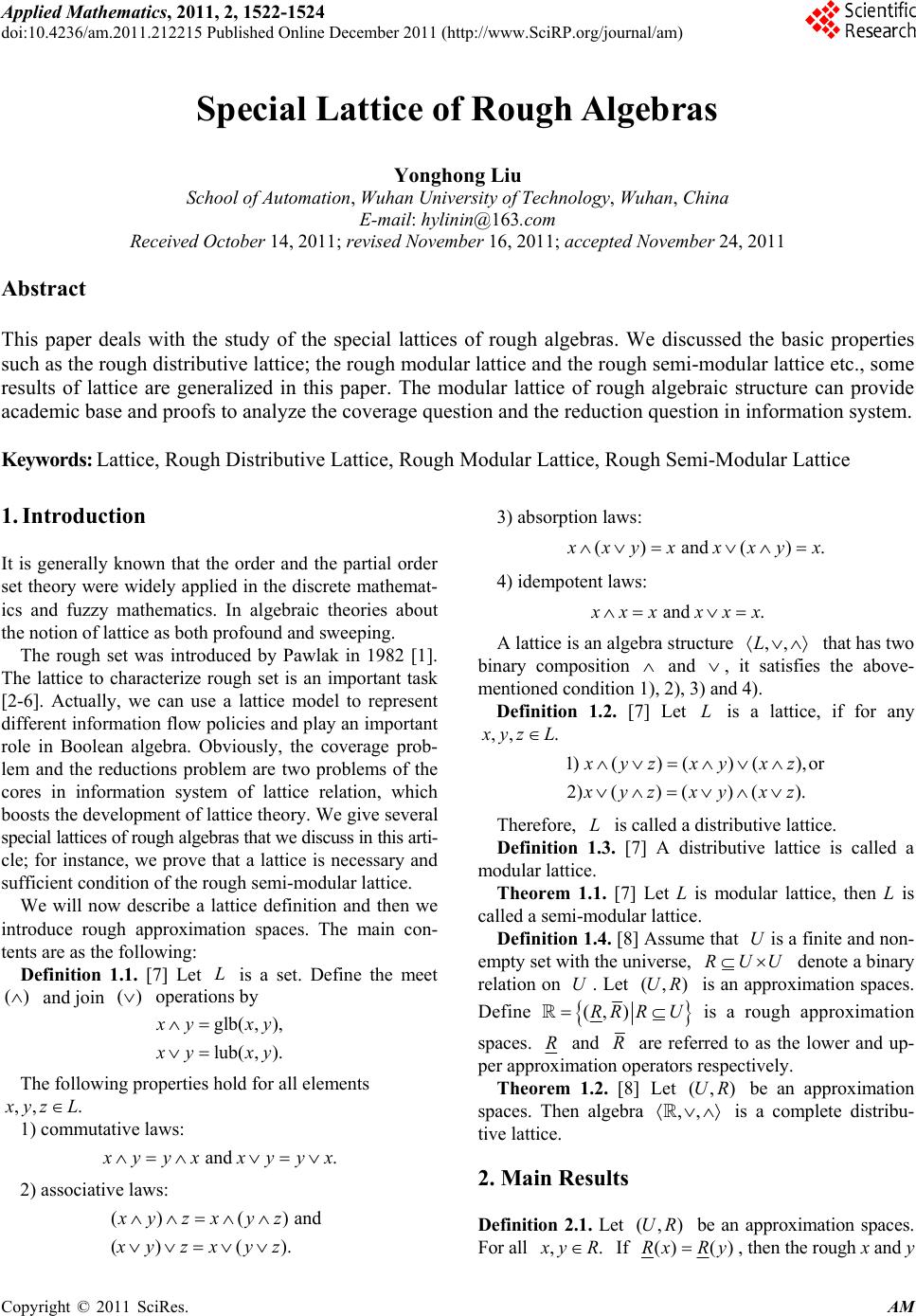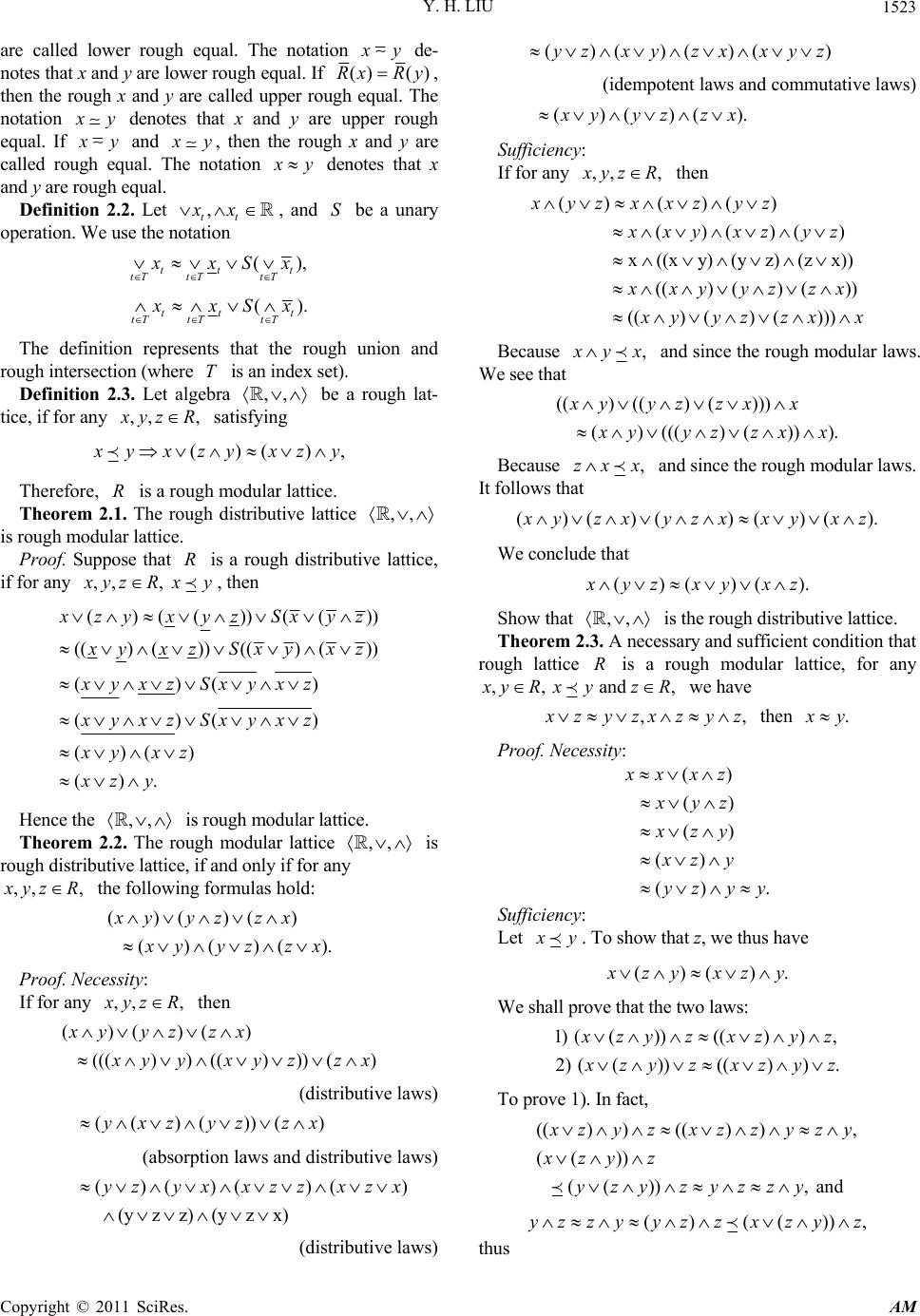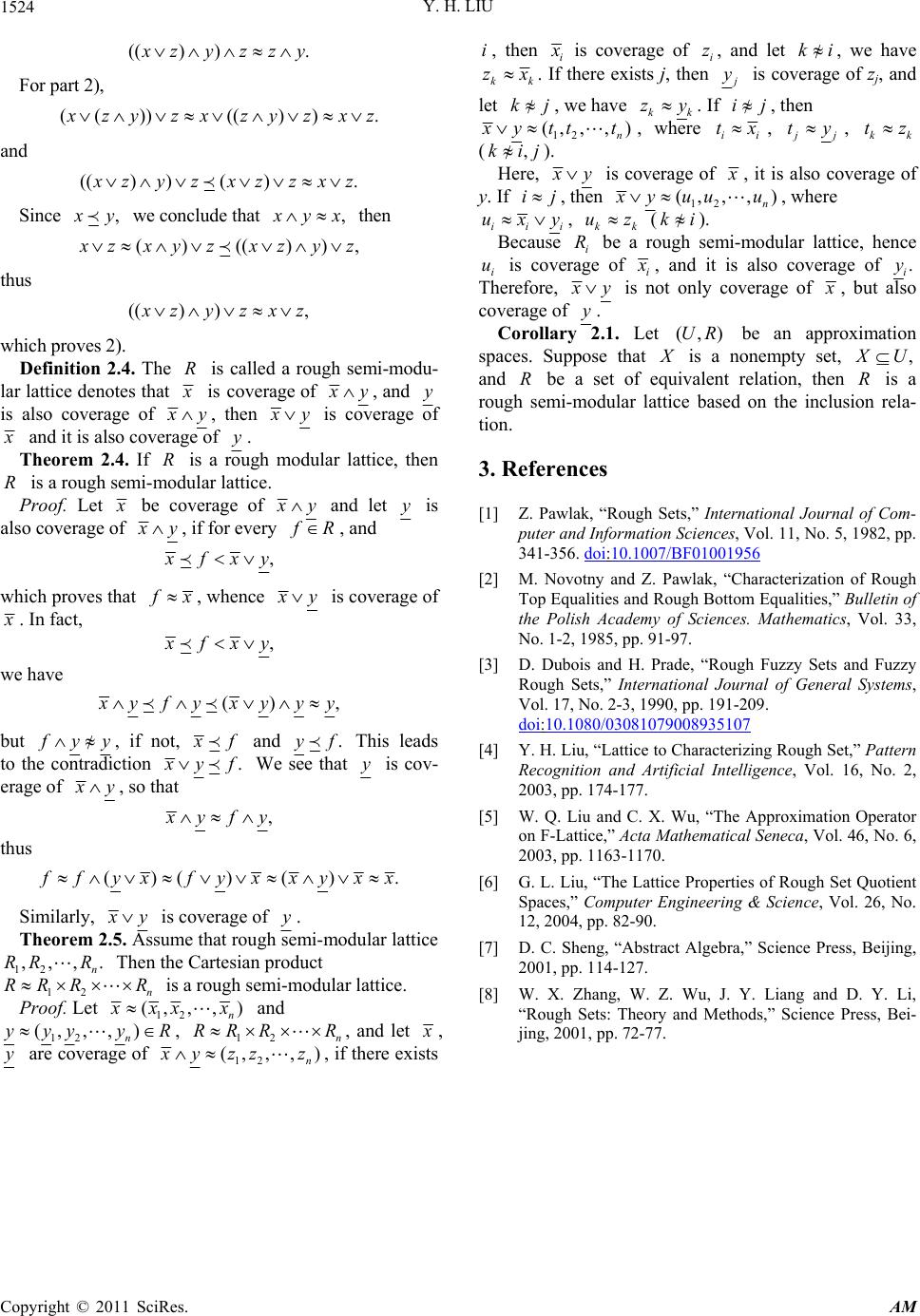 Applied Mathematics, 2011, 2, 1522-1524 doi:10.4236/am.2011.212215 Published Online December 2011 (http://www.SciRP.org/journal/am) Copyright © 2011 SciRes. AM Special Lattice of Rough Algebras Yonghong Liu School of Automation, Wuhan University of Technology, Wuhan, China E-mail: hylinin@163.com Received October 14, 2011; revised November 16, 2011; accepted November 24, 2011 Abstract This paper deals with the study of the special lattices of rough algebras. We discussed the basic properties such as the rough distributive lattice; the rough modular lattice and the rough semi-modular lattice etc., some results of lattice are generalized in this paper. The modular lattice of rough algebraic structure can provide academic base and proofs to analyze the coverage question and the reduction question in information system. Keywords: Lattice, Rough Distributive Lattice, Rough Modular Lattice, Rough Semi-Modular Lattice 1. Introduction It is generally known that the order and the partial order set theory were widely applied in the discrete mathemat- ics and fuzzy mathematics. In algebraic theories about the notion of lattice as both profound and sweeping. The rough set was introduced by Pawlak in 1982 [1]. The lattice to characterize rough set is an important task [2-6]. Actually, we can use a lattice model to represent different information flow policies and play an important role in Boolean algebra. Obviously, the coverage prob- lem and the reductions problem are two problems of the cores in information system of lattice relation, which boosts the development of lattice theory. We give several special lattices of rough algebras that we discuss in this arti- cle; for instance, we prove that a lattice is necessary and sufficient condition of the rough semi-modular lattice. We will now describe a lattice definition and then we introduce rough approximation spaces. The main con- tents are as the following: Definition 1.1. [7] Let is a set. Define the meet and join ( operations by L ()) glb( ,), lub( ,). yxy yx y The following properties hold for all elements ,, . yz L 1) commutative laws: and . yyxxyyx 2) associative laws: ()() and () (). xy zx yz xy zx yz 3) absorption laws: () and (). xyxx xyx 4) idempotent laws: and . xx xxx A lattice is an algebra structure that has two binary composition ,,L and , it satisfies the above- mentioned condition 1 ), 2), 3) and 4) . Definition 1.2. [7] Let is a lattice, if for any L ,, . yz L 1) ()()(),or 2)()() (). xyzxy xz xyzxy xz Therefore, is called a distributive lattice. L Definition 1.3. [7] A distributive lattice is called a modular lattice. Theorem 1.1. [7] Let L is modular lattice, then L is called a semi-modular lattice. Definition 1.4. [8] Assume that is a finite and non- empty set with the universe, denote a binary relation on . Let is an approximation spaces. U RUU U(,)UR Define (,)RR RU is a rough approximation spaces. R and R are referred to as the lower and up- per approximation oper ators respectively. Theorem 1.2. [8] Let be an approximation spaces. Then algebra (,)UR ,, is a complete distribu- tive lattice. 2. Main Results Definition 2.1. Let be an approximation spaces. For all (,)UR ,. yR If () ()Rx Ry , then the rough x and y  Y. H. LIU1523 are called lower rough equal. The notation y de- notes that x and y are lower rough equal. If () ()Rx Ry, then the rough x and y are called upper rough equal. The notation y denotes that x and y are upper rough equal. If y and y, then the rough x and y are called rough equal. The notation y denotes that x and y are rough equal. Definition 2.2. Let , and be a unary operation. We use the notation , tt xxS (), tt tT t tT tT xS x (). tt t tT tTtT xS x The definition represents that the rough union and rough intersection (where is an index set). T Definition 2.3. Let algebra ,, be a rough lat- tice, if for any ,, , yz R satisfying ()(), yxzy xzy Therefore, is a rough modular lattice. R Theorem 2.1. The rough distributive lattice ,, is rough modular lattice. Proof. Suppose that is a rough distributive lattice, if for any R ,, , yz R y, then ()(( ))(( (()())(() ()) ()() ()() ()() (). )) zyxyzSxyz yxzSxyxz xyxz Sxyxz xyxz Sxyxz xy xz xz y Hence the is rough modular lattice. ,, Theorem 2.2. The rough modular lattice is rough distributive lattice, if and only if for any ,, ,, , yz R the following formulas hold: ()()() ()()( xyyz zx ). yyzzx Proof. Necessity: If for any ,,, yz R then ()()() ((())(()))() xyyz zx yy xyz zx (distributive laws) (( )())(yxz yzzx ) ) ) (absorption laws and distributive laws) ()()( )( (yzz)(yzx) yzyx xzz xzx (distributive laws) ()()()(yz xy zxxyz (idempotent laws and commutative laws) ()()(). yyzzx Sufficiency: If for any ,, , yz R then () ()() ()()() x((xy)(yz)(zx)) (()()()) (()()())) xyzxxz yz xy xzyz xyyz zx yyzzx x Because , yx and since the rough modular laws. We see that (() (()())) ()((()()) xyyz zxx ). yyzzxx Because ,zxx and since the rough modular laws. It follows that ()()( )()(). yzxyzxxyxz We conclude that ()()(). yzxy xz Show that ,, is the rough distributive lattice. Theorem 2.3. A necessary and sufficient condition that rough lattice is a rough modular lattice, for any R ,, and ,yRxzRy we have ,, zyzxzyz then . y Proof. Necessity: () () () () () xx xz xyz xzy xz y yz yy. Sufficiency: Let y. To show that z, we thus have ()(). zyxzy We shall prove that the two laws: 1) (() )( ()), 2) (())(()). zyzxzy z zyzxzy z To prove 1). In fact, (( ))(( )), (( )) (()), and zyzxzzyzy xzy z yzy zyzzy () (())yzzyyz zx zyz, thus Copyright © 2011 SciRes. AM  Y. H. LIU Copyright © 2011 SciRes. AM 1524 (()). zyzzy For part 2), (( ))(( )). zyzxzy zxz and (( ))(). zyzxzzxz Since , y we conclude that , yx then () (()), zxyz xzyz thus (()), zyzxz which proves 2). Definition 2.4. The is called a rough semi-modu- lar lattice denotes that R is coverage of y, and is also coverage of y, then y is coverage of and it is also coverage of . Theorem 2.4. If is a rough modular lattice, then is a rough semi-modular lattice. R RProof. Let be coverage of y and let is also coverage of y, if for every R, and , fxy which proves that x, whence y is coverage of . In fact, , fxy we have () , yfyxyyy but yy , if not, f and . f This leads to the contradiction . yf We see that is cov- erage of y, so that , yfy thus ()()(). fyx fyxxyxx Similarly, y is coverage of . Theorem 2.5. Assume that rough semi-modular lattice Then the Cartesian product is a rough semi-modular lattice. 12 ,,,. n RR R RRR 12 Proof. Let n R 12 (, ,,) n xx x and 12 (, , ,) n yyy R, , and let 12 n RRR R , are coverage of 12 (, ,,) n yzz z , if there exists , then ii is coverage of , and let , we have i zki k zx k . If there exists j, then is coverage of zj, and let kj , we have kk zy . If ij , then 12 (, ,, ) n ytt t , where ii tx, j ty, kk tz (,kij ). Here, y is coverage of , it is also coverage of y. If ij , then 12 (, , , ) n yu uu, where iii uxy , kk uz (ki ). Because i be a rough semi-modular lattice, hence i is coverage of R ui , and it is also coverage of . i Therefore, y is not only coverage of , but also coverage of . Corollary 2.1. Let be an approximation spaces. Suppose that (,UR) is a nonempty set, , U R and be a set of equivalent relation, then is a rough semi-modular lattice based on the inclusion rela- tion. R 3. References [1] Z. Pawlak, “Rough Sets,” International Journal of Com- puter and Information Sciences, Vol. 11, No. 5, 1982, pp. 341-356. doi:10.1007/BF01001956 [2] M. Novotny and Z. Pawlak, “Characterization of Rough Top Equalities and Rough Bottom Equalities,” Bulletin of the Polish Academy of Sciences. Mathematics, Vol. 33, No. 1-2, 1985, pp. 91-97. [3] D. Dubois and H. Prade, “Rough Fuzzy Sets and Fuzzy Rough Sets,” International Journal of General Systems, Vol. 17, No. 2-3, 1990, pp. 191-209. doi:10.1080/03081079008935107 [4] Y. H. Liu, “Lattice to Characterizing Rough Set,” Pattern Recognition and Artificial Intelligence, Vol. 16, No. 2, 2003, pp. 174-177. [5] W. Q. Liu and C. X. Wu, “The Approximation Operator on F-Lattice,” Acta Mathematical Seneca, Vol. 46, No. 6, 2003, pp. 1163-1170. [6] G. L. Liu, “The Lattice Properties of Rough Set Quotient Spaces,” Computer Engineering & Science, Vol. 26, No. 12, 2004, pp. 82-90. [7] D. C. Sheng, “Abstract Algebra,” Science Press, Beijing, 2001, pp. 114-127. [8] W. X. Zhang, W. Z. Wu, J. Y. Liang and D. Y. Li, “Rough Sets: Theory and Methods,” Science Press, Bei- jing, 2001, pp. 72-77.
|